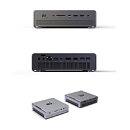
8-Core AMD Ryzen AI Max Pro 385 Benchmark Appears As Cheaper Strix Halo APU Launch Nears
It looks as though AMD might be planning to finally commercialize the more affordable version of its Ryzen AI Max APUs that have proven to be capable of powering impressively high-end gaming experiences. The first set of benchmarks of the new Strix Halo APU, dubbed the AMD Ryzen AI Max 385, have appeared on Geekbench, and the new APU is putting up some impressive numbers. AMD originally said that the Strix Halo line-up would be available between Q1 and Q2 2025, so the timing makes sense.
One major difference between the Ryzen AI Max 395 and the 385 is the iGPU, which is downgraded from the Radeon 8060S to the 8050S. When AMD launched the Strix Halo line-up, it revealed that AI Max Pro 385 would have an eight-core CPU paired with 32 graphics cores, instead of the 16-core CPU and 40-core iGPU setup. While we don't yet have GPU benchmark results for the 8050S, the CPU results put up by the APU are impressive on their own, with 2,489 points in the single-core benchmark and 14,136 points in the multicore benchmark. The laptop the new Ryzen silicon was tested in was an HP ZBook Ultra G1a with 32 GB of RAM. The results put the 385 only slightly behind the AI Max+ 395 in certain configurations, but in a similar HP ZBook Ultra G1a laptop, the Ryzen AI Max+ 395 comes out ahead of the 385 by as much as 45%. It's unclear just how much laptops with this new Ryzen AI Max Pro 385 APU will cost, but they will almost certainly be cheaper than the current crop of Ryzen AI Max+ laptops, which generally run well north of $2,000.
One major difference between the Ryzen AI Max 395 and the 385 is the iGPU, which is downgraded from the Radeon 8060S to the 8050S. When AMD launched the Strix Halo line-up, it revealed that AI Max Pro 385 would have an eight-core CPU paired with 32 graphics cores, instead of the 16-core CPU and 40-core iGPU setup. While we don't yet have GPU benchmark results for the 8050S, the CPU results put up by the APU are impressive on their own, with 2,489 points in the single-core benchmark and 14,136 points in the multicore benchmark. The laptop the new Ryzen silicon was tested in was an HP ZBook Ultra G1a with 32 GB of RAM. The results put the 385 only slightly behind the AI Max+ 395 in certain configurations, but in a similar HP ZBook Ultra G1a laptop, the Ryzen AI Max+ 395 comes out ahead of the 385 by as much as 45%. It's unclear just how much laptops with this new Ryzen AI Max Pro 385 APU will cost, but they will almost certainly be cheaper than the current crop of Ryzen AI Max+ laptops, which generally run well north of $2,000.







































































